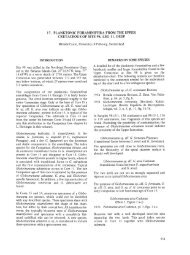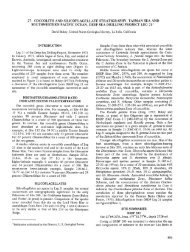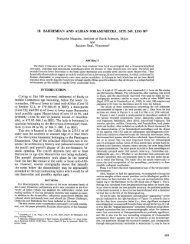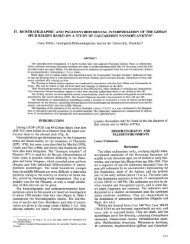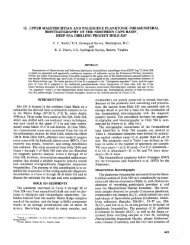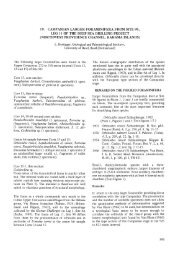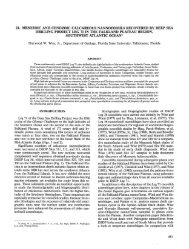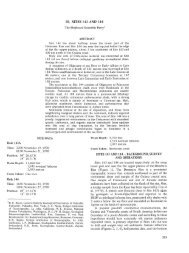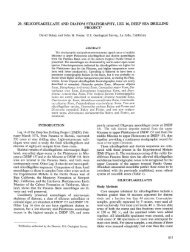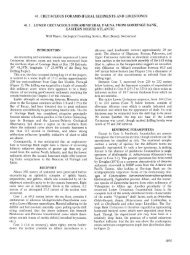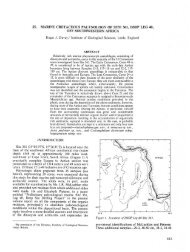16. Radiolaria - Deep Sea Drilling Project
16. Radiolaria - Deep Sea Drilling Project
16. Radiolaria - Deep Sea Drilling Project
You also want an ePaper? Increase the reach of your titles
YUMPU automatically turns print PDFs into web optimized ePapers that Google loves.
M. G. PETRUSHEVSKAYA, G. E. KOZLOVA<br />
Calocycletta acanthocephala (Ehrenberg)<br />
(Plate 35, Figures 5-7)<br />
Eucyrtidium acanthocephalum Ehrenberg, 1873, p. 225, 1875, pi.<br />
9, fig. 8.<br />
Cephalic horns, very similar to those in C. tuberosa forma A, are<br />
present. About 9 to 11 pores on half of the thoracic equator.<br />
Oligocene.<br />
Calocycletta virginis Haeckel sens. str.<br />
(Plate 35, Figures 8-10)<br />
Calocycletta virginis Haeckel, 1887, p. 1381, pi. 74, fig. 4; Riedel<br />
and Sanfilippo, 1970, p. 535, part, (non fig. 14, pi. 10) Riedel<br />
and Sanfilippo, in press, pi. 2H, figs. 8-11 {non figs. 5-9), part.<br />
ITheocyrtis tuberosa (Riedel) Moore, in press, pi. 5, fig. 5, part.<br />
About 12 to 15 pores on half of the thoracic equator. The<br />
external constriction between thorax and abdomen is distinct. The<br />
teeth of the abdomen may be undeveloped.<br />
Eocene, not Miocene.<br />
Calocycletta veneris Haeckel sens. str.<br />
(Plate 5, Figure 16)<br />
Calocycletta veneris Haeckel, 1887, p. 1381, pi. 74, fig. 5.<br />
Calocycletta virginis Haeckel, Riedel and Sanfilippo, 1970, p. 535,<br />
pi. 14, fig. 10; Riedel and Sanfilippo, in press, pi. 2H, figs. 5-7,<br />
part; Moore, in press, pi. 10, fig. 7.<br />
About 10 pores on half of the thoracic equator. No external<br />
constriction between thorax and abdomen, only an inner shelf.<br />
Abdominal teeth are distinct (if not broken). Riedel and Sanfilippo<br />
indicate the evolution of this species from forms similar to C.<br />
virginis (Riedel and Sanfilippo, in press, pi. 2H, figs. 8-11).<br />
Miocene. Characteristic for the zone called the "Calocycletta<br />
virginis Zone"; therefore (because typical C. virginis is absent in this<br />
zone) this zone must be named the "Calocycletta veneris Zone".<br />
Calocycletta costata (Riedel)<br />
(Plate 35, Figure 17)<br />
Calocyclas costata Riedel, 1959, p. 296, pi. 2, fig. 9.<br />
Calocycletta costata (Riedel) Riedel and Sanfilippo, 1970, p. 535,<br />
pi. 14, fig. 12; Moore, in press, pi. 10, fig. 8.<br />
lAnthocyrtium flosculus Haeckel, 1887, p. 1277, pi. 62,fig. 19.<br />
About 11 to 13 longitudinal rows of pores on half of the<br />
thoracic equator; they are separated by ridges. Teeth of the<br />
abdomen are very well developed.<br />
Miocene.<br />
Calocycletta tuberosa (Riedel)<br />
(Plate 35, Figures 11-14)<br />
Theocyrtis tuberosa Riedel 1959a, p. 298, pi. 2, figs. 10, 11; Riedel<br />
and Sanfilippo, 1970, p. 535, pi. 13, figs. 8-10; Moore, in press,<br />
pi. 5, fig. 6, part.<br />
About 15 to 18 pores on half of the thoracic equator. The<br />
surface of the thorax has small tuberculae. The teeth of the mouth<br />
are not developed.<br />
There are several forms (subspecies?) of this species.<br />
Calocycletta tuberosa forma A (Plate 35, Figures 11, 12), see<br />
Riedel and Sanfilippo (1970, pi. 13, fig. 9), has less pores on the<br />
thorax. The cephalis has the same horns that are characteristic for C.<br />
acanthocephala. C. tuberosa forma A and C. acanthocephala seem to<br />
be closely related and originate from one and the same ancestor. C.<br />
tuberosa forma A is restricted to Early Oligocene.<br />
Calocycletta tuberosa forma B (Plate 35, Figures 13, 14).<br />
Typical C. tuberosa. It is distinguished from C. tuberosa forma A,<br />
1) by a greater number of pores, 2) by more pronounced tuberculae,<br />
and 3) by the narrower cephalis without the additional horns.<br />
Restricted to Oligocene.<br />
Remark: The generic identification is emended for the following<br />
reasons. C. tuberosa resembles Eucyrticium barbadense Ehrenberg<br />
(1875, pi. 9, fig. 7, the type species of Theocyrtis, which is<br />
somewhat similar in the upper two segments of the skeleton to<br />
Calocycletta costata) no more than it resembles Calocycletta veneris<br />
(the type species of Calocycletta). Taking into account the relation<br />
between C. veneris and C. virginis on the one hand, and the relation<br />
between C. virginis and C. tuberosa on the other, it seems likely that<br />
there existed two lines from one and the same ancestor. Both lines<br />
may be included in one and the same genus Calocycletta.<br />
544<br />
Calocycletta tuberosa forma C was figured by Riedel and<br />
Sanfilippo (in press, pi. 3D, figs. 16 and 18) as Theocyrtis sp. aff. T.<br />
tuberosa. It has tuberculae only on the upper part of the thorax. On<br />
the lower part of the thorax there are longitudinal ribs, as<br />
characteristic for C. annosa. Calocycletta tuberosa forma C is very<br />
similar to C. virginis in the shape and size of the test, and also in the<br />
number and disposition of the pores.<br />
Late Eocene-Early Oligocene.<br />
Calocycletta annosa (Riedel)<br />
Phormocyrtis annosa Riedel, 1959a, p. 295, pi. 2, fig. 7.<br />
Theocyrtis annosa Riedel and Sanfilippo, 1970, p. 535, pi. 15, fig.<br />
9; Moore, in press, pi. 7, fig. 7.<br />
Seems to originate from Calocycletta tuberosa forma C.<br />
Oligocene-Miocene.<br />
Genus LAMPROCYCLAS Haeckel<br />
Lamprocyclas Haeckel, 1881, p. 434; 1887, p. 1390; Campbell,<br />
1954, p. 132. = Lamprocyclia Haeckel, 1887, p. 1390; Campbell,<br />
1954, p. 132; Nigrini, 1967, p. 74; Petrushevskaya, 1971b, p.<br />
232. Type species Lamprocyclas nuptialis Haeckel (1887, pi. 74,<br />
fig. 15).<br />
Theocorbis Haeckel, 1887, p. 1401; Campbell 1954, p. 134. Type<br />
species Theoconus jovis Haeckel (1887, pi. 69, fig. 4).<br />
Craterocyclas Haecker, 1908, p. 454; Campbell, 1954, p. 127. Type<br />
species Craterocyclas robustissima Haecker (1908, p. 85,<br />
fig. 596).<br />
Hexalodus Haecker, 1908, p. 456; Campbell, 1954, p. 134. Type<br />
species Hexalodus dendroporus Haecker (1908, p. 85, fig. 593).<br />
Cephalis is as a rule nearly cylindrical, but sometimes conical<br />
(wide at its base). Abdomen as a rule is longer and broader than<br />
thorax [In Theocorythium (Plate 36, Figure 15) it is smaller].The<br />
mouth of the abdomen is somewhat constricted. As a rule, margin is<br />
poreless. It may be elongated into a peristome. Peristome may have<br />
festoons or teeth. The walls of the abdomen very often have horns<br />
(teeth?). The peristomial and abdominal teeth may constitute a<br />
"double corona".<br />
Paleogene-Recent.<br />
Lamprocyclas rhinoceros (Haeckel)<br />
(Plate 36, Figure 1-3)<br />
Lophoconus rhinoceros Haeckel, 1887, p. 1405, pi. 69, fig. 2.<br />
Cephalis has a tube, which is more or less developed in various<br />
specimens.<br />
Oligocene.<br />
Lamprocyclas sp. A<br />
(Plate 36, Figure 4)<br />
ICalocyclas parthenia Haeckel, 1887, p. 1385, pi. 74, fig. 1.<br />
Calocyclas hannai Campbell and Clark, 1944a, p. 48, pi. 6, figs.<br />
21,22.<br />
Abdomen (without peristome) 100-120µ long and 130-15 Oµ<br />
broad. About 12 longitudinal rows or pores on the half equator of<br />
the abdomen.<br />
Miocene.<br />
Lamprocyclas aegles (Ehrenberg) group<br />
(Plate 36, Figure 13)<br />
Podocyrtis aegles Ehrenberg, 1854, pi. 35, B IV, fig. 18;<br />
Petrushevskaya, 1971b, pi. 116, fig. 1.<br />
IPhormocampe lamprocyclas Haeckel, 1887, p. 1457, pi. 77, fig. <strong>16.</strong><br />
lLamprocyclas maritalis antiqua Riedel, 1953, p. 811, pi. 85, fig. 8.<br />
Abdomen 50-70µ broad. About 11 or 12 longitudinal rows of<br />
pores on the half equator of the abdomen.<br />
Miocene-Quaternary.<br />
Lamprocyclas maritalis Haeckel<br />
(Plate 36, Figure 14)<br />
Lamprocyclas maritalis Haeckel, 1887, p. 1390, pi. 74, figs. 13, 14;<br />
Nigrini, 1967, p. 74, pi. 7, fig. 5.<br />
Differs from Lamprocyclas sp. A by the length of the<br />
abdomen-it is about 70-80µ long (without peristome). About 14 or<br />
15 longitudinal rows of pores on the half equator of the abdomen.<br />
Pliocene-Quaternary.



